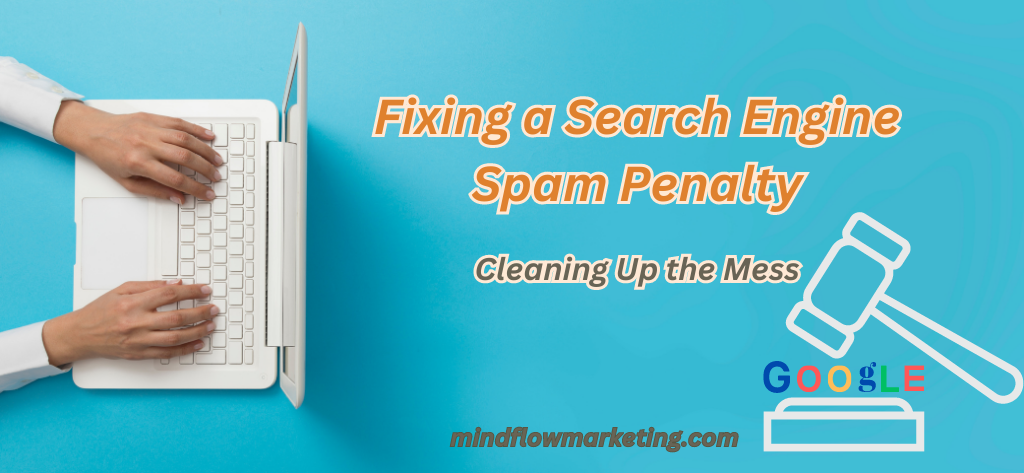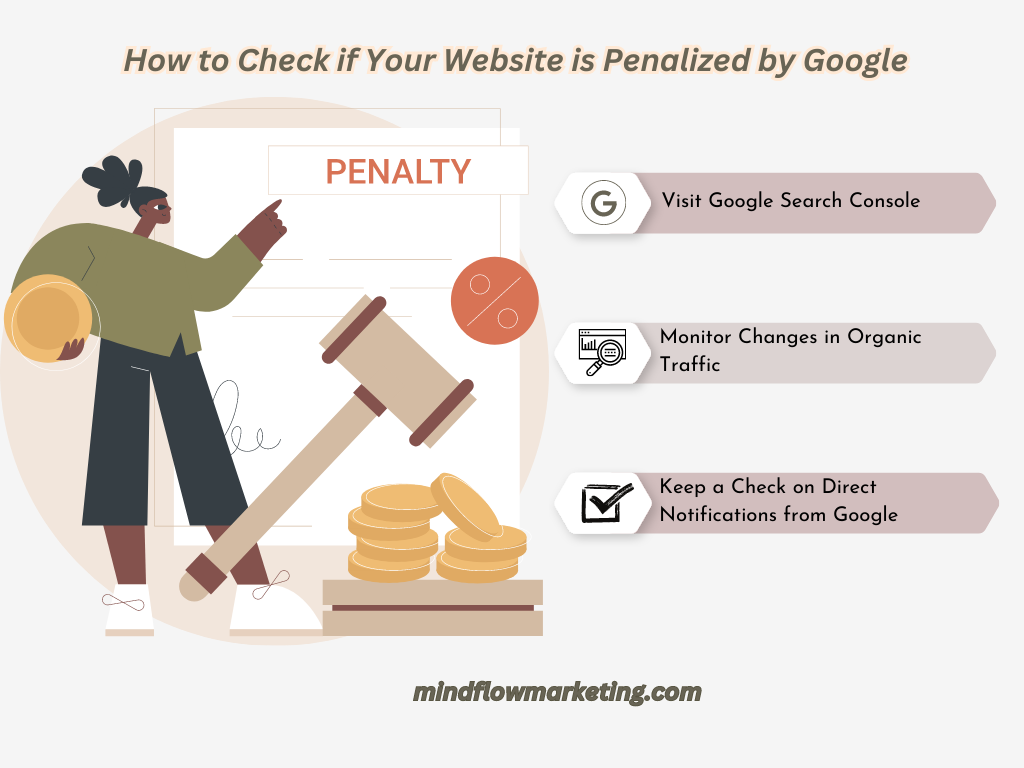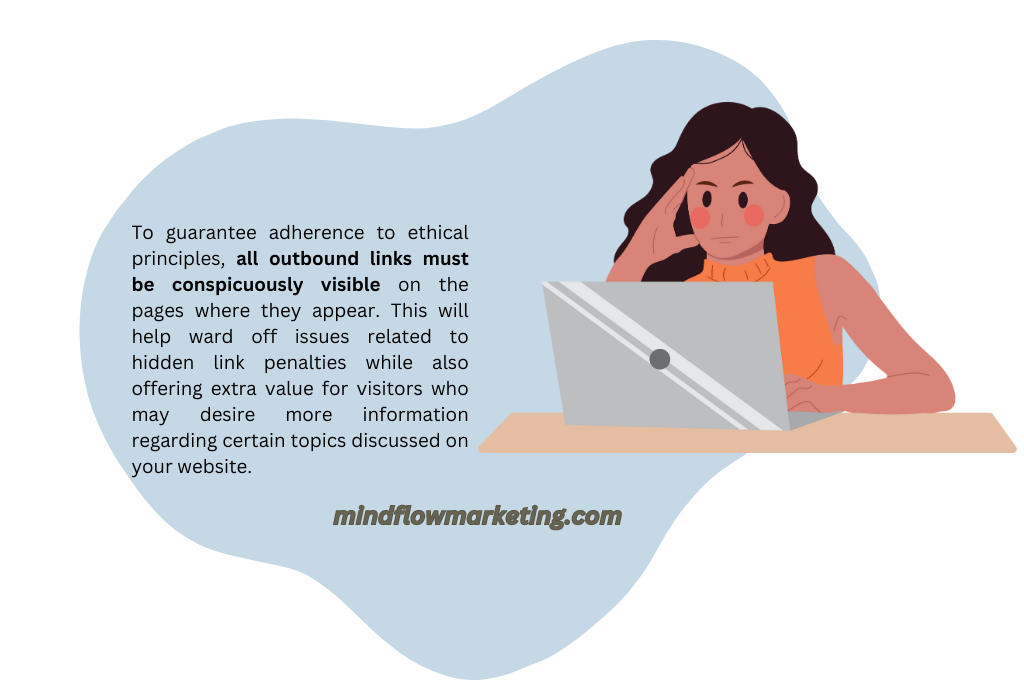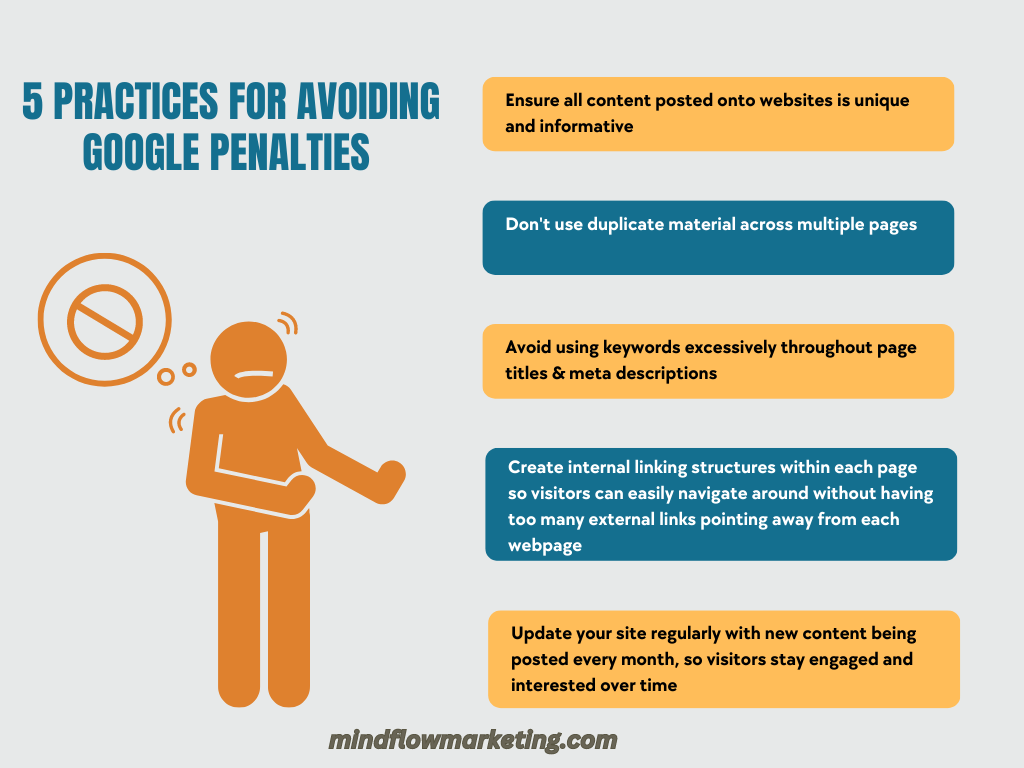SEO is an indispensable part of any website, and ranking on search engines can be a determining factor in its success. In this blog post, we will discuss some essential elements that can help improve your website’s visibility on the Google search console.
For instance, to improve your website’s visibility on Google Search Console, we will first conduct a site audit to identify potential issues that may negatively impact its performance. We’ll also cover manual penalties and how to avoid them by following webmaster guidelines.
We’ll explore ways to optimize your content with relevant keywords and meta descriptions to boost organic traffic. We’ll investigate the influence of backlinks on your website’s ranking and how to construct top-notch links proficiently.
So, if you’re looking for practical tips on improving your website’s search engine results, then this blog post is perfect for you!

What Are Search Engine Spam Penalties
Google penalties are like a red card in soccer – if you don’t follow the rules, you’re out of the game. Google penalties can be given automatically by algorithms or manually by human auditors.
Some penalties come from algorithm updates such as Panda and Penguin, while others may be due to an honest mistake or even an error on Google’s end.
When a penalty is issued, your website will no longer appear in search results, or its ranking for targeted keywords could drop significantly. This means that any traffic coming from organic searches will also decrease drastically.
To make matters worse, it can take months before a penalty is lifted and your site regains visibility. These penalties are designed to stop black-hat SEO tactics and other online rule-breakers, but they can also happen to sites that have done nothing wrong at all.
Types of Search Engine Spam Penalties
It’s important to note that there are two types of spam penalties.
Both of these require different approaches when trying to fix them.
Manual spam usually requires submitting reconsideration requests directly through Google Webmaster Tools, while algorithmic ones need more technical fixes, such as fixing broken links or improving page speed performance issues, etc.
In short, understanding how Google penalizes websites for violating their guidelines is essential if you want your website to remain visible in SERPs over time. Otherwise, one misstep could cost you dearly.
How to Know if I Received a Google Penalty
If you’re a website owner, it’s important to know if you have received a Google penalty. A manual penalty from Google can devastate your website traffic and rankings.
Fortunately, there are ways to check if you have been penalized by the search engine giant.

The first thing to do is visit the Google Search Console (formerly known as Webmaster Tools). This free tool provides detailed information about your site’s appearance in search results.
Once logged in, go to Security and Manual Actions and then click on Manual Actions.
If all is well, you should see a green checkmark with “No issue detected” written next to it – this means that no manual action has been taken against your site by Google.
The screenshot is taken from NeilPatel.com Source Google Search Console
It’s also worth noting that not all penalties will show up in the Search Console; some may only appear when searching for specific keywords or phrases related to your website content.
For example, if one of your pages was penalized for having too many keyword-stuffed links pointing back at it from other websites, those links would still exist but wouldn’t necessarily show up in the Search Console report.
To find out more about these types of penalties, use tools like Moz Pro or Majestic SEO, which provide comprehensive link analysis reports showing where each link originates from and what kind of anchor text they contain (if any).
Another way to tell whether or not you’ve received a penalty is by monitoring changes in organic traffic over time using analytics software such as Google Analytics or Adobe SiteCatalyst.
If there’s an unexpected drop off after making certain changes onsite – such as adding new content or updating existing pages – then this could indicate that something isn’t quite right with how Google views your site, and further investigation may be required into potential causes behind this sudden decrease in visits from organic sources (i.e., unpaid natural search engine listings).
Keep an eye out for notifications sent directly from Google via email or within their various products/services like AdWords and YouTube Ads Manager. These messages usually explain why certain actions were taken against accounts associated with them. So, read through them carefully before taking any corrective measures.
What Causes Search Engine Spam Penalties & How to Fix them
Search engine spam penalties are caused by a variety of factors, all of which can hurt your website’s ranking.
Therefore, be mindful when using automated tools such as bots or scrapers to generate new pages/posts on your website, for they can result in duplicate content issues.
If two pieces of identical (or near-identical) content exist online, only one version will be indexed by Google. Thus, it is important to know where each piece was published first before reusing it elsewhere.
Below, we’ve discussed a few causes for search engine spam penalties and ways to fix them.
#1. Automatic Content Creation
Automatic content creation is a method of generating web pages or blog posts without any human input. It has become increasingly popular among marketers and website owners looking to quickly create large amounts of content for their websites.
However, unfortunately, this practice can be seen as a form of search engine spam penalty by Google and other major search engines.
Search engines use algorithms to determine the quality and relevance of web pages to rank them accordingly in their results pages.
When they detect that automated content has been used, it can result in lower rankings for the page or even removal from the index altogether. This is because automated content often lacks originality, meaning it doesn’t provide any value to users searching for information on that particular topic.
How to Fix it?
#2. Hidden Links
Hidden links are a type of search engine spam penalty that can seriously impact your website’s ranking. Search engines like Google and Bing use algorithms to detect hidden links, which spammers often use in an attempt to manipulate search engine rankings.
Hidden links are generally created using HTML code that hides them from users but still allows them to be crawled by search engine bots.
This is done either by making the link color match the background or setting its font size too small for it to be visible.
Using hidden links is considered unethical as they do not provide any value to visitors and only serve as a way for websites to gain an unfair advantage over their competitors in terms of SEO rankings.
Furthermore, if caught using these tactics, you may face severe penalties from major search engines, such as being removed from their index altogether or having your site downgraded significantly in terms of visibility and page rank.
How to Fix it?

Web admins and SEO professionals need to comprehend how hidden links operate to evade any potential punishments from major search engines such as Google or Bing.
To guarantee adherence to ethical principles, all outbound links must be conspicuously visible on the pages where they appear. This will help ward off issues related to hidden link penalties while also offering extra value for visitors who may desire more information regarding certain topics discussed on your website.
Furthermore, it is always recommended that internal linking should be done correctly since this can have a detrimental effect on your overall SEO performance if not performed accurately or without proper optimization techniques applied.
#3. Duplicate Content
Duplicate content is a major issue for search engine optimization (SEO). It occurs when two or more web pages have the same or very similar content.
This can happen when websites copy and paste from each other, create multiple pages with the same information, or use syndicated feeds to generate content. According to a study, up to 29% of pages have duplicated content. Search engines penalize sites that contain duplicate content because it dilutes their ability to provide relevant results to users.
How to Fix it?
And if you need to reuse some text from another page on your site, be sure to rewrite it in your own words so that it isn’t considered duplicate content by search engines.
For example, if you have an e-commerce store with product pages on both www.example.comproduct1 and www2example2comproduct1, then you can specify which one should be indexed using a canonical tag in the HTML code for each page.
This will help ensure that only a one-page version is indexed by search engines and prevent potential penalties due to duplicate content issues.
For instance, if someone visits www3example3compageA but this URL has been redirected via 301 redirects back to www4example4compageB, then no duplication will occur since all visitors will land directly at page B instead of seeing two versions of the same thing at different URLs first before being redirected away again.
By adding specific instructions within these tags, such as ‘noindex’ or ‘nofollow’ directives – crawlers will know not to crawl certain sections or follow links within them either, respectively, meaning fewer chances for accidental duplication occurring after that indeed.
#4. Irrelevant Keywords
Using irrelevant keywords in your website content can be a costly mistake. Search engine algorithms are designed to detect and penalize websites that use these types of words.
Irrelevant keywords are those which have nothing to do with the topic at hand or don’t add any value to the content.
For example, if you’re writing about SEO (Search Engine Optimization), using terms like “pizza” or “baseball” would be considered irrelevant keywords. And hereunder, we’ve mentioned the consequences of stuffing irrelevant keywords alongside ways to fix the issue.
Google’s algorithm is constantly evolving and getting smarter, so it can easily identify when irrelevant keywords are used on a website. When this happens, Google will lower the ranking of that page in its search engine results pages (SERPs).
This means fewer people will find your site when they search for related topics – resulting in less traffic and fewer conversions for your business.
Another consequence of using irrelevant keywords is that it could lead to an increase in bounce rate – meaning visitors leave quickly after visiting one page on your site without exploring further into other areas, such as products or services you offer.
This could also result in reduced customer loyalty over time as users become frustrated by having their searches polluted with unrelated information from sites trying to game the system by stuffing their pages with useless keyword phrases.
How to Fix it?
It’s important not only to avoid spammy tactics like stuffing pages full of irrelevant keywords but also to ensure all content is relevant and useful for readers who visit your website.
Or otherwise, you’ll risk alienating your customers instead of engaging them with valuable information they’re looking for online.
So, think twice before adding any extra “fluff” into web pages just because it might help boost rankings temporarily – it could cost more than what was gained!
#5. Bad Redirects
Bad redirects are a major issue when it comes to search engine optimization (SEO). Redirects are used to direct visitors from one page or website to another, and if done incorrectly, they can lead to penalties.
A bad redirect is any type of redirect that isn’t properly set up, such as a 301 or 302 status code. This could be an incorrect URL, an outdated link, or even a broken link.
Search engines use algorithms to determine the quality of websites and pages to rank higher in search results. If your website has bad redirects, it will affect its ranking negatively as the algorithm will see it as spammy behavior, which could result in your site being penalized by Google or other search engines.
How to Fix it?
To avoid this problem, limit the number of redirects you use on your site and only utilize those necessary for navigation.
#6. Cloaking
Cloaking is a search engine optimization (SEO) technique used to deceive search engines and users. It involves presenting different content or URLs to human users than those presented to search engine crawlers, which can result in a penalty from the search engine for attempting to manipulate rankings.
The goal of cloaking is usually to improve the ranking of a website on SERPs by making it appear more relevant than it actually is.
For example, if a web page contains text that is not optimized for SEO but has highly optimized images, cloaking could be used so that only the images are shown when crawled by the search engine bots while all other content remains visible when accessed directly through the URL.
Cloaking can also be used as an attempt at black hat SEO tactics such as keyword stuffing or link spamming.
In this case, cloaked pages will contain hidden links and keywords intended solely for boosting rankings without providing any real value or relevance to visitors who click on them.
This type of activity often results in penalties from Google and other major search engines since they consider it deceptive and manipulative behavior designed purely for gaining higher rankings rather than providing useful information or services.
In addition, some websites may use cloaking techniques simply because they don’t want their competitors to see what content they have published online. However, this practice should still be avoided, as most major search engines frown upon any form of deception regardless of intent.
How to Fix it?
Cloaking should never be attempted unless you understand exactly how it works and why it’s considered unethical by most major players in the industry – including Google – since there’s always potential risk involved with using these types of techniques, even if done unintentionally or unknowingly.
Instead, if you’re looking for ways to boost your website’s visibility without resorting to shady tactics like cloaking, then focus instead on creating high-quality content that provides real value to both humans and robots alike.
#7. Bad Links (Also Known as “Link Farms”)
Bad links, or “link farms,” are a major search engine penalty that can severely damage your website’s ranking. Link farms involve linking out exclusively to low-quality websites with little value beyond backlinks.
Google has been actively penalizing sites that use link farms to reduce spam and improve the overall quality of their search results. One way to identify bad links is by looking at the anchor text used for each link. If all of the anchor texts are identical or similar, it could be a sign of a link farm.
Additionally, if you notice any suspicious patterns, such as multiple outgoing links from one page or too many outgoing links on one page, this could indicate a link farm issue.
Another important factor when assessing bad links is the domain authority (DA) score of each linked site. Sites with high DA scores tend to have more trustworthiness and relevance than those with lower scores – so look out for any sites linking back to yours with low DA scores.
This will help you determine whether they’re providing genuine value or just trying to manipulate rankings through shady tactics like link farming.
How to Fix it?
In conclusion, avoiding any spammy behavior when optimizing your website for better visibility will go a long way toward ensuring you don’t incur any unnecessary penalties from major search engines like Google or Bing.
How Soon Will My Site Recover From a Google Penalty?
When it comes to Google penalties, the amount of time it takes for a website to recover can vary greatly.
The best way to speed up your site’s recovery from a penalty is by making sure all errors are corrected as soon as possible and submitting a thorough reconsideration request with supporting evidence that shows Google why they should lift the penalty.
This could include screenshots of any changes made or links showing positive reviews from customers interacting with your business online.
It’s also important to remain patient throughout this process because even if everything looks good on paper, there’s no guarantee when (or if) Google will decide to lift your penalty.
Another factor in determining how long it will take for your site’s ranking position and traffic levels to return back to normal is related directly to competition within your industry niche or market segment – meaning if other competitors are doing well, then it may be more difficult for you to regain lost ground simply because there isn’t enough room at the top of search engine results pages (SERPs).
In order words, don’t expect miracles overnight.
Note: Many times, people think they’ve been hit with a “Google Penalty” when in reality, what has happened was their website just wasn’t optimized properly or had too many technical issues, which caused them not to rank highly in SERPs – so make sure you know exactly what type of problem you’re dealing with before attempting any fix.
Best Practices For Avoiding Penalties In The Future

Now that we know how difficult recovering from penalties can be – let’s focus our attention on avoiding them altogether.
Here are some tips for staying off google’s bad side while still achieving high SERP rankings.
Request Reconsideration
After cleaning up your website and removing all traces of spammy content, it’s finally time to submit a reconsideration request directly through Google Search Console (formerly known as Webmaster Tools).
In this request, explain in detail what changes were made on your site and how they address the issues that caused the initial penalty for Google bots to crawl over them again without triggering another violation warning message or, worse yet – another manual action against your domain name itself.
After submitting a reconsideration request, monitor closely how quickly (or slowly) progress is being made towards getting out from under this particular search engine penalty. And if there isn’t much movement after several weeks, then consider reaching out directly via email or phone call so that someone at Google’s headquarters can review things manually before making their final decision on whether or not reinstatement will occur soon enough.
After a search engine spam penalty, clean up the mess. With careful planning and research, you can identify what caused your penalty and take steps to fix it. It is essential to utilize sound strategies for averting future punishments and instruments and assets that will enable you to clean up your site rapidly and proficiently. To ensure that your penalty-cleaning efforts are not in vain, it is important to avoid repeating the same mistakes.